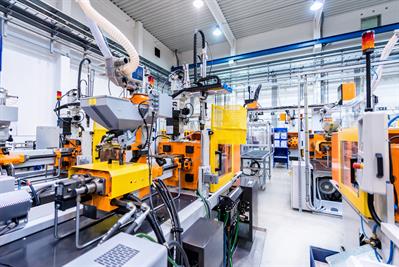
Originally adopted in 1991, ANSI B11.20 was the first standard to address the safety of complex automation systems created by integrating individual machines into a larger coordinated system.
The standard establishes requirements for the construction, operation and maintenance of integrated manufacturing systems (IMS), with the goal of controlling or eliminating hazards to personnel working on or near them.
ANSI B11.20 defines an IMS as a system that:
a) incorporates two or more industrial machines that
i) can operate independently of each other; and
ii) are intended for the purpose of manufacturing, treatment, movement or packaging of discrete parts or assemblies;
b) is linked by a material handling system;
c) is interconnected by a control system(s) for coordinated operation
The standard was recently updated to a third edition (B11.20-2017) that takes into account current industry best practices applicable to IMS.
One change of note in the third edition is updated terminology designed to be more in line with global standards. For instance, “safeguarding” is now referred to as “risk reduction measures/engineering controls” and the term “awareness devices” has been replaced by “awareness means.”
Another significant change in B11.20-2017 is the addition of new zone classifications and elaboration on special modes. In addition to the existing “zone” and “hazard zone” terms, the revised edition includes the terms “task zone” and “control zone.” These terms were added to expand on the concept of layout analysis, which can be used to determine zones and define spans of control for safety-related control devices. This includes the minimum level of safety performance for a device.
OSH professionals in the manufacturing and machinery safety fields should familiarize themselves with B11.20-2017 in order to mitigate or eliminate risks and hazards associated with IMS. A risk assessment can facilitate this process to consider the reasonably foreseeable hazards associated with design, installation, operation and maintenance.
It is important to bear in mind that an IMS should be considered a new and different machine, rather than the sum of its parts. When different pieces of equipment and/or machines are integrated into an IMS, new risks and hazards arise that may not have been considered by the OEM.
This will require OSH professionals to think outside the box to identify hazards, given that the number and types of risks and hazards in an IMS will depend on the nature of the automation process as well as the complexity of the installation.
What this means is that organizations have 30 months from the approval of the standard (Sept. 12, 2017) to complete and implement design changes to IMS. Furthermore, the B11.20 subcommittee recommends that users evaluate whether existing IMS have acceptable risk within the same 30-month period using generally recognized risk assessment methods. If a risk assessment demonstrates that modifications are necessary, suppliers should consult B11.20-2017 requirements for appropriate risk reduction measures.
Purchase a copy of ANSI B11.20-2017.
Choose the Right Safety Management System
We have the resources and expert support you need to make informed decisions and drive results at your organization.
Learn more